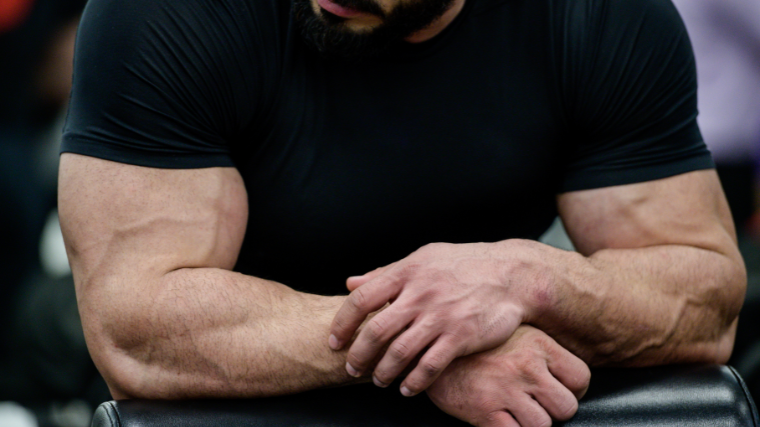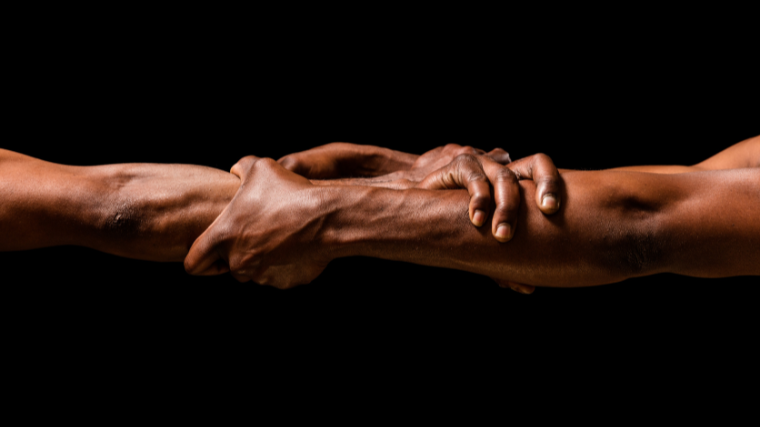There (probably) isn’t a gym rat on the face of the Earth who neglects their arms. After all, your biceps and triceps are some of the top glamor muscles. Even at a young age, an adult probably invited you to “make a muscle” by flexing your arm. But what of the forearms?
In the realm of bodybuilding, the devil is often in the details. Smaller, secondary muscles like your forearms don’t get the lion’s share of the limelight, but they do a lot for the overall appearance of your physique.

You might think that simply holding onto a dumbbell or barbell is enough forearm work to build them up. While this may be true for beginners, if you want to build forearms that Popeye would envy — without slamming down multiple cans of spinach — you’ll have to train them directly.
The Best Forearm Workouts for Bodybuilding
- Best Bodybuilding Forearm Workout — Beginner
- Best Bodybuilding Forearm Workout — Intermediate
- Best Bodybuilding Forearm Workout — Advanced
Beginner Bodybuilding Forearm Workout
For rank beginners, muscles like the calves, abdominals, and especially your forearms tend to grow on their own by virtue of resistance training itself. After all, these muscles play a large role in supporting your mechanics while you lift.
As such, most beginning physique aspirants don’t need to give their forearms too much attention in the first few years. They should grow just fine on their own, provided you’re gripping properly and training your arms or back.
The Workout
A good back and biceps workout will give your forearms more than enough stimulation to grow. If you’re new to lifting weights, your forearms likely aren’t used to maintaining a closed fist against significant resistance.
Standard “pulling” movements in which gravity is attempting to yank the weight of your hand will do just fine.
- Deadlift: 3 x 5
- Barbell Row: 3 x 5
- Assisted Wide-Grip Pull-Up: 2 x 10
- Hammer Curl: 2 x 12
Note that you can train your forearms with or without this specific workout. The deadlift, pull-up, and any manner of row are all fantastic options for early forearm growth, while also giving you a lot of back stimulation to boot.
Intermediate Bodybuilding Forearm Workout
With a few years of real gym experience under your belt, it might be a suitable time to start assessing your physique for strengths and weaknesses. If you feel your forearms are lagging behind or are disproportionately underdeveloped, you can begin to add some dedicated work to your training plan.
The Workout
At an intermediate level (think between three and six years in the game), you probably don’t even need a dedicated “forearm day” yet. What you can do, though, is plug a couple of forearm-specific movements into the tail end of any workout.
Training forearms as a capstone to your back or arm days makes sense from a congruence perspective, but you can also do some forearm exercises after leg training if you want to hammer them while they’re fresh.
- Dumbbell Row: 3 x 8
- Wide-Grip Lat Pulldown: 3 x 10-12
- Dumbbell Pullover: 2 x 10-12
- Hammer Curl: 2 x 8-10
- Reverse Curl: 2 x 12-15
- Cable Wrist Curl: 2 x 15
As you can see, this back-and-biceps workout sneaks in plenty of forearm stimulation without requiring it to be the centerpiece of your session.
As you move through the workout, the exercises demand more and more of your forearm and grip strength, culminating with a loaded carry that tests how long you can squeeze your hand shut.
Advanced Bodybuilding Forearm Workout
Whether you’ve pocketed your pro card years ago or simply want to build the most impeccably-developed physique you can, advanced bodybuilders need to give attention to even the smallest muscles that many others overlook.
Your forearms are no different. Dedicated forearm work takes time out of your likely-busy gym schedule, but it’s the best way to make a stubborn muscle grow if compound lifting isn’t enough.
The Workout
You have two options for forearm training as an advanced physique athlete — you can give them their own day entirely, or train your forearms when you first walk into the gym for another session.

[Read More: Our Favorite Forearm Workouts, + the Best Forearm Exercises]
As long as you don’t kick off a back workout with forearm exercises (it might be hard to hold onto heavy rows if your grip is torched), you can get a good session in 15 to 20 minutes and still have plenty of time (and energy) left over for the rest of your day.
- Cambered Bar Reverse Spider Curl: 3 x 12
- Cable Wrist Curl: 2 x 12-15
- Cable Wrist Extension: 2 x 12-15
- Dumbbell Wrist Rotation: 1 x 15-20
- Plate Pinch or Farmer’s Carry: 3 sets for maximum distance or time.
An advanced forearm workout will exercise each of the small functions your forearms perform. This means loading the motor patterns of flexion, extension, and rotation, as well as incorporating some isometric crushing via curls and carries.
Anatomy and Function of the Forearm
Your forearm is one of the most complex pieces of muscular machinery on your body. There aren’t just one or two muscles that affect the motion of your wrist and hand — there are dozens.
As such, memorizing every individual muscle tissue between your wrist and elbow isn’t exactly a practical use of your time. More importantly, it probably won’t do much to bolster the efficacy of your workouts.
However, understanding the anatomical function and motor behavior of those muscles might help you understand the “why” behind the forearm exercises you have in your routine.
Wrist Flexion
Your brachioradialis, flexor carpi radialis, and flexor carpi ulnaris are three of the bigger muscles on the underside of your forearm. They help perform the action of wrist flexion, which draws your palm downward.
They also provide a lot of heft to the appearance of your forearm. You can train this action with all manner of resistance, but dumbbells and cables are the most common tools.
Wrist Extension
Extension, or bending your wrist backward, is the opposite function of wrist flexion. The musculature on the top of your forearm assists in performing this action.
You’ll generally notice that wrist extension is more difficult to perform than flexion, and you may have a reduced range of motion as well. As such, wrist extension exercises are commonly performed with very light weights, but are equally important for balanced muscular development.
Wrist Rotation
The wrist joint doesn’t actually rotate — the bones of your forearm do. Your forearm consists of two primary bones, the radius and ulna. These two bones twist around one another to rotate your forearm and hand in space.
While rotation exercises are great, they may not necessarily be the best bang for your buck for muscle growth. However, rotation and flexion-extension movements have been shown to be beneficial for remedying certain cases of elbow pain. (1)
Crushing/Gripping
The ability to close your hand around an object is crucial for all manner of exercise, particularly upper-body resistance training. After all, you can’t grow your pecs or blast your lats if you can’t hold on to a weight in the first place.
The motor action of clasping something in your palm is actually performed by the many, many tiny ligaments and tendons in your hand, and isn’t strictly caused by muscular contraction. However, the soft tissues in your hand attach to the muscles of your forearm.

This is why, even without a flexion-extension cycle, isometric movements like the plate pinch, farmer’s carry, or deadlift will tax your forearms to a serious degree as they strain to keep your fingers wrapped snugly around whatever you’re holding.
Forearm Training Tips
Training your muscles properly is an art. This is as true for your quadriceps or shoulder as it is for the tiny muscles in your forearms. While the rules of hypertrophy remain the same no matter what muscle you’re working on, there are unique tactics you can employ when working on your forearms that might improve your results.
Start Slowly
If you’re brand new to the gym, you probably don’t need to do dedicated forearm work as those muscles work to adjust to the rigors of resistance training.
Even if you’re quite comfortable lifting weights already, you shouldn’t dive headfirst into a bunch of bonus forearm work on top of your existing routine.
Your forearms may be bearing a lot of training volume that you don’t consciously notice, so be sure to add additional work with caution and in small increments.
Don’t Go (Too) Heavy
Progressive overload is essential to long-term muscle growth, plain and simple. However, the “smaller” the exercise, the harder it will be to add noticeable amounts of weight.
If you’re performing wrist curls with a 10-pound dumbbell, for instance, moving to the 15-pounders represents a 50% increase in resistance — a dramatic jump you would never make on an exercise like the squat or overhead press.
As such, be wary of trying to beef up your forearms via using heavier and heavier weights. You’ll probably get stronger over time, but don’t force the issue. Your form is likely to degrade rapidly and you may even put yourself at risk of injury.
Use Strict Tempo
Tempo refers to the cadence at which you lift or lower a weight. While moving fast or explosively is great for developing muscular power, you should take things much slower if you’re training your forearms.
Many of the motor functions your forearms perform are at least partially assisted by the connective tissues in your wrists and fingers. These tendons and ligaments aren’t really susceptible to hypertrophy, but they can bear force.
If you knock out your wrist curls or extensions sloppily, you run the risk of your soft tissues bearing load that should be placed on your muscles.
Get Creative With Your Equipment
The barbell is the de-facto weapon of choice for strength athletes. Most bodybuilders tend to be quite fond of it as well. However, you may have to use your noodle a bit if you want to comprehensively train your forearms.
Your wrist anatomy is highly individual. The range of motion you have in flexion, extension, or rotation is quite limited when compared against other larger joints, which may make it difficult to feel comfortable performing forearm exercises with a barbell (or even dumbbells).
Don’t be afraid to look beyond free weights. You can train your forearms with cables, resistance bands, lacrosse balls, weight plates, or even a PVC pipe and some string if you have them on hand.
Forearm Gains Matter
Your arm is more than just your biceps and triceps. Your shoulders — and, obviously — your forearms contribute a great deal to how jacked you look overall.
In fact, the appearance of your forearms signals that you work hard in the gym even if you aren’t at the gym (or the beach). Whether you’re wearing a t-shirt or a button-down with the sleeves rolled, your forearms are on full display more often than you might think.
If they’re the first impression you make with your physique, you’d better make sure they’re up to snuff.
References
1. Lee JH, Kim TH, Lim KB. Effects of eccentric control exercise for wrist extensor and shoulder stabilization exercise on the pain and functions of tennis elbow. J Phys Ther Sci. 2018 Apr;30(4):590-594. doi: 10.1589/jpts.30.590. Epub 2018 Apr 20. PMID: 29706713; PMCID: PMC5909009.
Featured Image: Ruslan Shugushev / Shutterstock